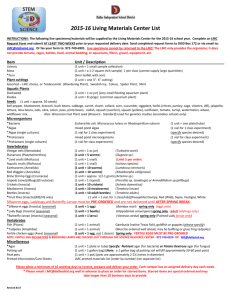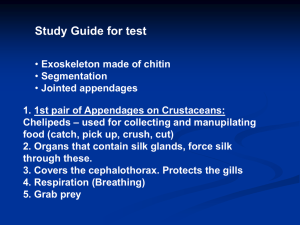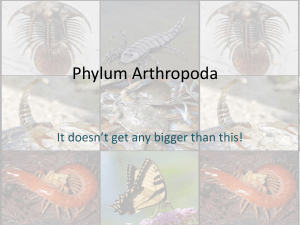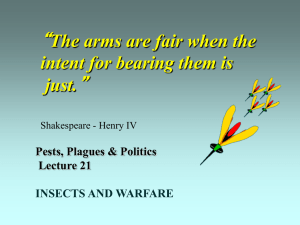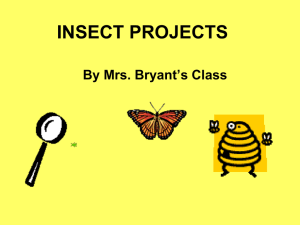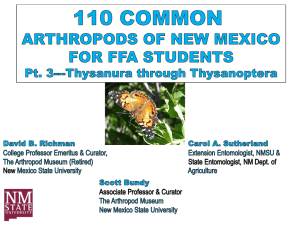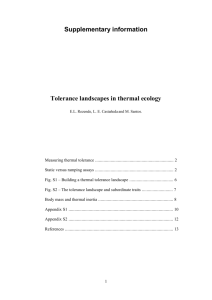The Arthropods: Part 2
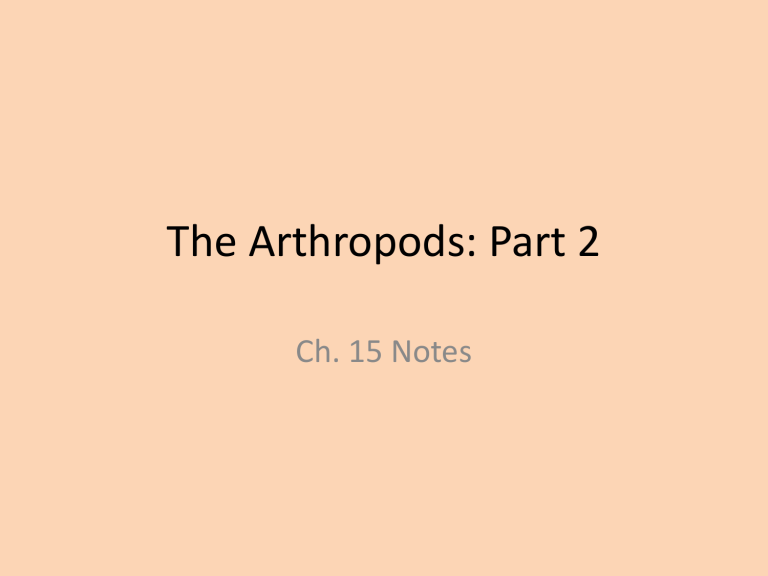
The Arthropods: Part 2
Ch. 15 Notes
Phylum Arthropoda Review
5 Subphyla:
1. Trilobitomorpha – extinct – trilobites
– Marine
– Cambrian-Carboniferous time period
2. Chelicerata – spiders, mites, ticks, horseshoe crabs, sea spiders, scorpions
3. Crustacea – ‘hard shelled’ – crayfish, shrimp, lobster, crabs, water fleas, barnacles
4. Myriapoda – millipedes & centipedes
5. Hexapoda – ‘six legs’ – insects & their relatives
Subphylum Myriapoda
• Class Diplopoda – two-fold foot
– Millipedes
– 11-100 trunk segments
– Two pairs of appendages on each trunk segment
– Actually the fusion of two segments
• 2 ostia – opening @ end of oviduct
• 2 ganglia
• 2 tracheal trunks – part of circulatory system – transports O
2
– Glands produce Hydrogen Cyanide to repel other animals
– Round bodies in cross section
Subphylum Myriapoda
• Class Chilopoda – lip foot
– Centipedes
– Nocturnal
– Flattened bodies in cross section
– Poison claws
– Only 1 pair of appendages per segment
– Add legs and segments with each molt
Subphylum: Hexopoda
• Includes Insects & their relatives
• Body divided into 3 Tagmata:
– Head, thorax, abdomen
• 5 pairs of head appendages
• 3 pairs of legs on the thorax (6 legs)
Class Insecta
Habitat:
• terrestrial, aquatic, & aerial
– Insects are the most successful land animals
Class Insecta
Locomotion
• Flight is the most important form of locomotion
– Insects were 1 st animals to fly
– Must be able to thermoregulate
• Maintain body temperatures different from environment
• Walk/Run
• Jump
• Swim
Class Insecta
Thermoregulation
• Ectotherms
– Most insects
– Rely on sun or warm surface
• Heterotherms
– Rely on metabolic heat
– Shivering Thermogenesis
• Generate heat by rapid contraction of flight muscles
Class Insecta
Digestive Tract
• Long & Straight
• 3 Regions
– Foregut
• Musculary pharynx/oral cavity
• Used for sucking fluids
• Crop (storage)
• Gizzard (regulates movement to midgut; grinds food)
– Midgut
• Surface for digestion & absorption
– Hindgut
• The Intestine
• Reabsorption of Water
Class Insecta
Excretory System
• Nitrogenous wastes converted to uric acid
– conserves water
– energetically expensive
• Malpighian tubules transport uric acid to the digestive tract
Class Insecta
Respiration – a Simple System
• Have trachea- chitin lined tubes
– Open to outside through spiracles
– Oxygen diffuses from trachea to body tissues
• Aquatic insects
– Spiracles are nonfunctional
– Gasses diffuse across body wall
• Blood is not important for gas exchange in insects
Class Insecta
Do insects have blood?
Circulatory System
• Open Circulatory System
• Less developed blood vessels
• Blood distributes nutrients, hormones, & wastes
Class Insecta
Nervous Communication
• Pheromones – Chemicals released by one individual that affects the behavior of another
– Chemoreceptors – pores through which chemicals diffuse
• Feeding
• Selection of egg laying sites
• Mate location
• Social organization
Class Insecta
Nervous Communication Continued…
• Hormones regulate
– Ecdysis
– Metamorphosis
• Eclosion – the emergence of an insect from a cocoon, chrysalis, or puparium
– Cocoon- Protective case enclosing the pupal stage, made of silk
– Chrysalis- Last larval exoskeleton maintained during the pupal stage
– Puparium- an outer covering that protects the pupae of some flies
Class Insecta
Nervous Communication
Continued…
• Insects are capable of memory
• Johnston’s organs – the base of the antennae of most insects
– Long setae that vibrate when certain frequencies of sound strike them
– Mosquitoes and fruit flies hear using the Johnston's organ
Class Insecta
Nervous Communication Continued…
• Sense organs
– Mechanoreceptors – perceive physical displacement of the body or body parts
– Setae – distributed over mouthparts, antennae, legs
• Touch, air movements, and vibrations move setae
– Stretch Receptors – located @ joints & muscles
• Monitor position and posture
Class Insecta
Nervous Communication
Continued…
Sound
• Tympanic organs
– Consist of a thin, membrane covering a large air sac
– Air sac acts as a resonating chamber
– Sensory cells under membrane to detect pressure waves
Class Insecta
Nervous Communication Continued…
Sight
• All insects are capable of detecting light
• Compound Eyes
– Well developed eyes
– Not a very good image
– Good at detecting movement
– Sometimes can detect polarized light
– Made up of 1000’s of Ommatidia
• Each is a lens w/ a crystaline cone
• Cells have a rhabdom light collecting area
– Converts light energy into nerve impulses
• Ocelli – simple eyes
– Hundreds of photo receptors
Class Insecta
Reproduction
• Adaptations for land
– Resistant eggs
– External genitalia
– Behavioral mechanisms that bring males and females together at appropriate times
• Pheromones
• Visual signals
• Auditory signals
Class Insecta
Relationships
• Many insects are social
– They live in colonies
– Each kind of individual in an insect colony is called a caste
• Many are beneficial to humans
• Few are parasites or transmit diseases to humans or plants
